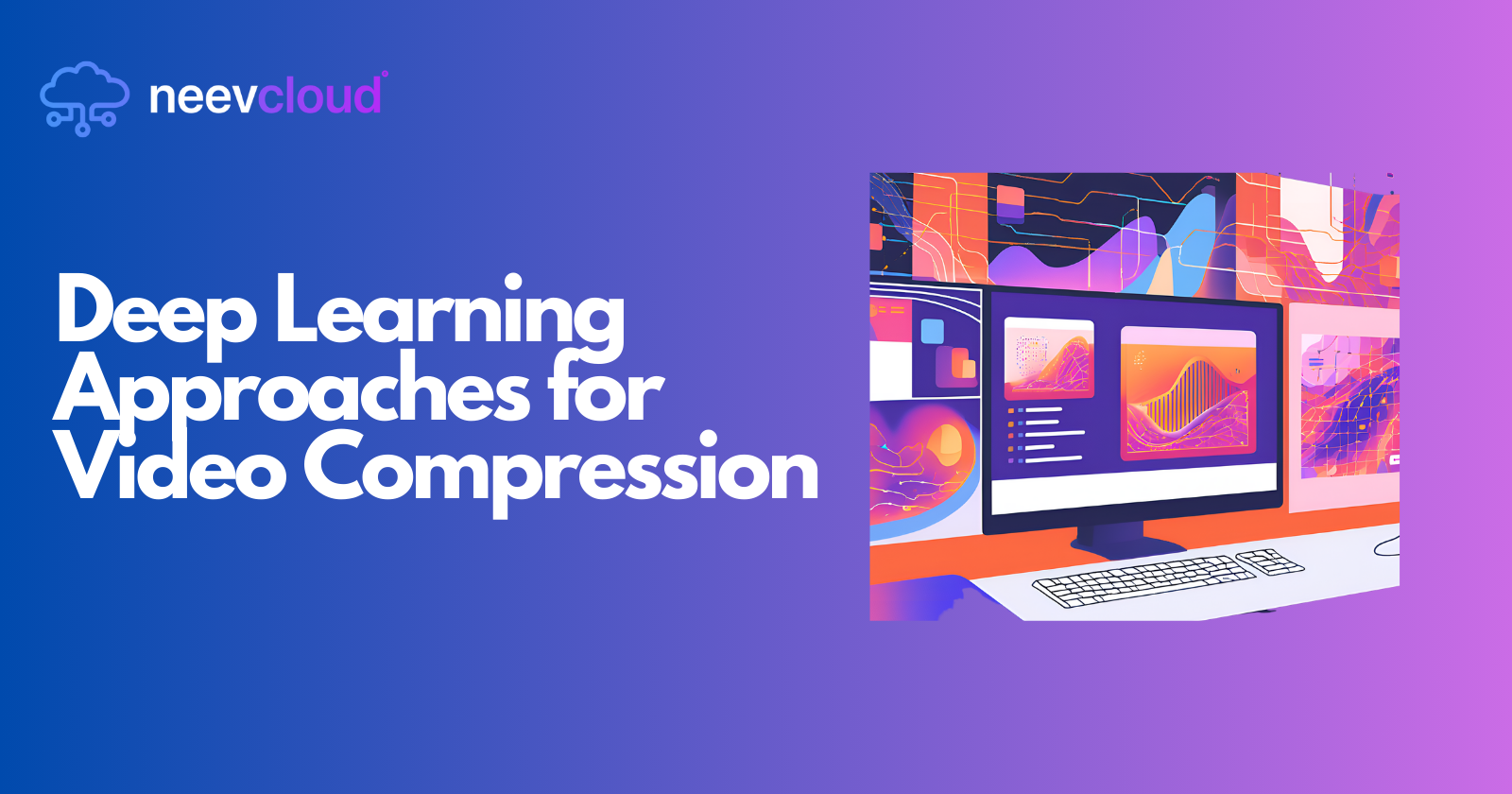Deep Learning Approaches for Video Compression
 Tanvi Ausare
Tanvi Ausare
In today’s digital landscape, video content dominates online data, contributing to massive traffic across AI cloud and AI datacenters. With billions of hours of video content being consumed daily, effective video compression has become crucial to enhancing data efficiency, reducing storage costs, and improving transmission speed. Traditional video compression methods, such as MPEG and H.264, have served their purpose. However, as the demand for high-definition (HD), 4K, and even 8K video grows, these techniques fall short. Deep learning approaches to video compression offer advanced, adaptive solutions to meet modern requirements.
This blog explores how deep learning networks and AI transform video compression, bringing game-changing impacts to AI datacenters and cloud-based video streaming services.
Why Deep Learning for Video Compression?
Deep learning approaches leverage artificial intelligence to achieve more efficient and dynamic video compression. Here are some key reasons why deep learning is ideal for this task:
High Adaptability: Deep learning models can adapt to different video content, whether high-motion sports clips or slow-paced educational videos.
Efficiency with High Resolution: Traditional compression methods often struggle with high-definition video. Deep learning networks excel in reducing the bandwidth of high-resolution videos.
Scalability in AI Clouds: By using AI-driven compression, AI datacenters can save storage costs and manage resources more effectively, meeting the scale required for large-scale video storage and delivery.
Reduced Latency: Deep learning models can process video data faster, lowering latency and improving real-time video delivery.
Let’s delve deeper into the leading deep learning approaches that are pushing the boundaries of video compression.
Key Deep Learning Approaches to Video Compression
1. Autoencoders for Video Compression
Autoencoders are neural networks designed to reduce data dimensions without significant loss in quality. In video compression:
Encoder-Decoder Architecture: Autoencoders learn a compact representation of video frames, compressing them during encoding and reconstructing the original frames upon decoding.
Generative Power: Autoencoders can generate high-quality, compressed frames by focusing on essential data and discarding redundant information.
Variable Compression Ratios: These models can dynamically adapt compression ratios based on video content complexity, making them suitable for diverse use cases in AI cloud applications.
Latency Reduction: Ideal for live video streaming where latency must be minimized.
2. Convolutional Neural Networks (CNNs) in Video Compression
Convolutional neural networks have been pivotal in image processing tasks, and their applications extend to video compression:
Feature Extraction: CNNs extract spatial features from video frames, allowing for more efficient compression by focusing only on essential data.
Improved Compression Efficiency: By learning intricate patterns and textures, CNNs compress video with minimal loss of detail, making them valuable for cloud-based high-resolution video storage.
Enhancement Layers: CNNs can use multi-layered structures to process fine details, ideal for high-definition video, where every pixel matters in maintaining quality.
Use in Hybrid Compression Models: CNNs are frequently combined with traditional video codecs to optimize both storage and computational efficiency.
3. Recurrent Neural Networks (RNNs) for Temporal Consistency
Since videos are sequences of frames, understanding temporal relationships is crucial for quality compression. RNNs specialize in such tasks:
Learning Temporal Patterns: RNNs, particularly Long Short-Term Memory (LSTM) networks, capture dependencies across video frames, preserving video quality.
Minimizing Motion Artifacts: By learning motion patterns, RNNs reduce issues like ghosting or artifacts in compressed video.
Adaptive Compression: RNNs adjust compression levels in response to the motion complexity within the video.
Real-Time Applications: Effective for real-time video processing, such as in AI datacenters managing live-streamed video data.
4. Variational Autoencoders (VAEs) for Generative Compression
Variational autoencoders (VAEs) represent an evolution of the traditional autoencoder, adding a probabilistic element to improve quality:
Probabilistic Latent Space: VAEs model video data using a probabilistic latent space, preserving video quality even at high compression rates.
High-Level Abstraction: By focusing on essential elements, VAEs eliminate unnecessary details and compress video while maintaining key content.
Reduction in File Size: VAEs offer a reduction in video file sizes with fewer artifacts, useful for AI cloud storage solutions and AI datacenters managing vast video libraries.
Ideal for Cloud Storage Solutions: The compressed video from VAEs requires less cloud storage, reducing operational costs and optimizing storage in AI datacenters.
5. Generative Adversarial Networks (GANs) for Video Prediction and Compression
Generative Adversarial Networks (GANs) consist of two networks—a generator and a discriminator—that work in tandem, perfect for high-quality video compression:
Predictive Compression: GANs can predict and generate subsequent video frames, eliminating the need to store each frame individually.
Adversarial Learning: The discriminator network ensures compressed video quality by evaluating the output against original frames, minimizing compression artifacts.
Dynamic Frame Generation: GANs are adept at handling high-motion video by learning to generate realistic frames, making them effective for real-time applications in AI clouds.
Bandwidth Optimization: GAN-based compression is highly efficient, allowing reduced data transmission in AI datacenters and on cloud platforms.
6. Transformers in Video Compression
Originally developed for natural language processing, transformers are now making waves in video compression:
Attention Mechanisms: Transformers use self-attention to focus on significant portions of each frame, achieving efficient compression.
Frame Relevance Selection: The transformer model assigns weights to each part of the video, compressing frames with minimal degradation.
Handling Large Datasets: Ideal for large-scale video datasets, transformers help AI clouds and AI datacenters manage significant video data efficiently.
Scalability in Cloud Solutions: Transformers scale seamlessly with AI cloud storage, enabling high-quality compression for massive data needs.
Advantages of Deep Learning Approaches in Video Compression
Integrating deep learning approaches for video compression offers unique advantages for modern AI applications:
Superior Quality at Low Bitrates: Deep learning models can compress video at low bitrates while preserving visual quality, unlike traditional codecs.
Enhanced Storage Efficiency: AI datacenters benefit from deep learning-based compression as it reduces storage requirements.
Cost-Effectiveness: Lower storage and bandwidth requirements lead to cost savings for AI cloud service providers.
Real-Time Compression for Streaming: Reduced latency in deep learning compression models improves real-time video streaming experiences.
Key Use Cases of Deep Learning in Video Compression
Deep learning in video compression can address various applications in the AI industry:
Video Streaming Services: Companies like Netflix and YouTube can use deep learning for real-time video compression to deliver high-quality videos without buffering.
AI Datacenter Optimization: AI datacenters that store and process large-scale video data, like surveillance footage, benefit from reduced storage and faster data retrieval.
Augmented and Virtual Reality: AR and VR applications rely on real-time video compression, where deep learning models can maintain quality and low latency.
Telemedicine and Remote Education: With deep learning compression, video quality remains high, even in low bandwidth situations, ensuring smooth video transmission for critical applications.
Challenges and Considerations in Deep Learning Video Compression
While deep learning brings transformative benefits to video compression, it also presents challenges that need addressing:
High Computational Costs: Training deep learning models requires considerable processing power, especially for high-definition video compression, demanding robust AI cloud infrastructure.
Complex Model Management: Deploying and updating compression models across datacenters can be resource-intensive.
Data Privacy and Security: Video data often contains sensitive information, so deep learning models must maintain data security during compression.
Performance Optimization for Edge Devices: Running complex models on edge devices, where computational resources are limited, requires optimized model architectures.
Future of Deep Learning in Video Compression
With ongoing advances in AI and deep learning, video compression technology is likely to become increasingly sophisticated:
Hybrid Models: Future models may combine multiple deep learning techniques, like autoencoders with GANs, for improved compression efficiency.
AI-Driven Codec Development: New codecs designed specifically for AI clouds and datacenters will emerge, reducing reliance on traditional methods like H.264 and MPEG.
Enhanced Real-Time Capabilities: Future models will focus on reducing latency even further, enabling seamless real-time video compression on a large scale.
Edge AI Integration: Lightweight models will be deployed on edge devices, allowing for local video compression without transmitting data to the cloud, thus saving bandwidth.
Conclusion
Deep learning approaches for video compression are redefining efficiency and quality in video content delivery, providing powerful tools for AI clouds and datacenters. By leveraging sophisticated models like autoencoders, GANs, and transformers, companies can store and deliver high-quality video with lower bandwidth and storage demands, leading to significant cost savings.
NeevCloud stands at the forefront of integrating these technologies, offering robust, AI-driven solutions tailored to meet modern compression needs in today’s data-intensive environment. As the demand for high-quality video grows, so does the need for innovative, deep learning-based video compression solutions, positioning AI clouds and datacenters for an optimized and data-efficient future.
Subscribe to my newsletter
Read articles from Tanvi Ausare directly inside your inbox. Subscribe to the newsletter, and don't miss out.
Written by
